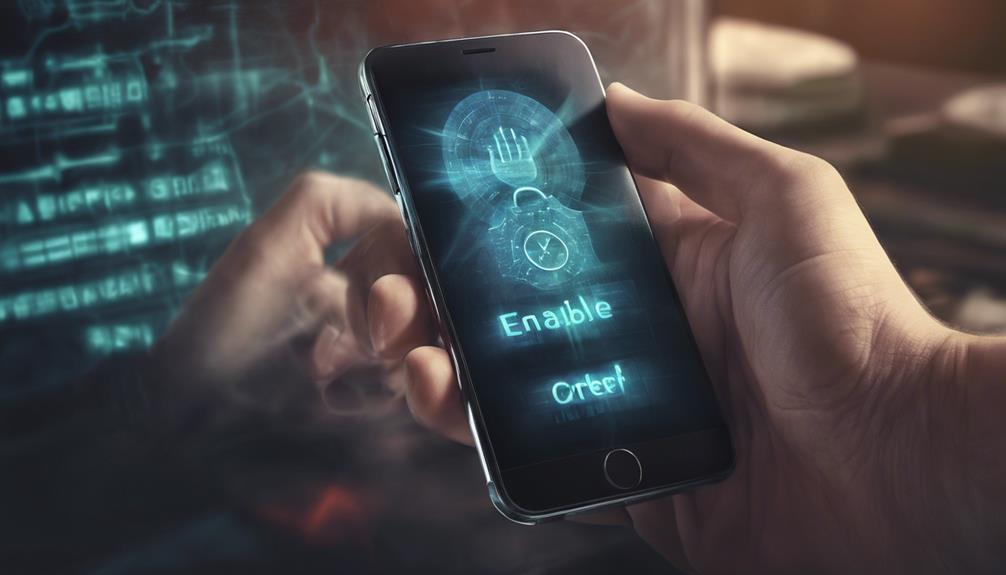To safeguard your phone from hackers, make sure you update your software regularly to patch vulnerabilities efficiently. Review app permissions meticulously to limit access to personal data. Implement biometric authentication such as facial recognition for added security layers. Enable auto-erase and remote wipe features to protect your data if the device is lost or stolen. Utilize tracking services and device locking for enhanced security measures. Manage passwords securely using a password manager and avoid auto-login functions. These steps fortify your device against potential threats effectively.
Key Takeaways
- Keep software updated for essential security patches.
- Manage app permissions to limit data access.
- Enable biometric authentication for robust security.
- Utilize auto-erase and remote wipe features.
- Activate tracking and locking services for protection.
Update Software Regularly
Keeping your phone's software up to date is crucial for safeguarding it against potential hacking threats. Software updates play a vital role in enhancing phone security by patching security vulnerabilities that hackers could exploit.
These updates often include important security patches and bug fixes that strengthen your phone's defenses, making it more challenging for malicious individuals to breach your device. By regularly updating your phone's software, you greatly reduce the risk of falling victim to hacking attacks.
Moreover, setting your phone to automatically update software ensures that you stay protected with the latest security features without having to manually intervene. Failure to update your software in a timely manner leaves your device more susceptible to hacking attempts, emphasizing the importance of staying current with software updates.
Review App Permissions Carefully

When considering the security of your phone, an important step is to thoroughly review app permissions to prevent unauthorized access to sensitive data. App permissions dictate what personal information an app can access on your device.
It is essential to be cautious when granting these permissions, as some apps may request unnecessary access to sensitive data, potentially putting your privacy at risk. Regularly checking and managing app permissions guarantees that only essential permissions are granted, limiting the exposure of your personal information to potential threats.
By restricting app permissions to only what is necessary for the app to function properly, you can better protect your privacy and prevent unauthorized access to your sensitive data. Avoiding unnecessary app permissions is key to safeguarding your personal information from hackers who may exploit vulnerabilities to gain access to your data.
Stay vigilant and prioritize reviewing and managing app permissions to enhance the security of your phone.
Enhance Security With Biometrics

Utilizing biometric authentication on your phone offers a heightened level of security by utilizing unique physical traits such as fingerprints or facial features for secure access. Biometric features like facial recognition or fingerprint scanning provide a more robust form of phone security compared to traditional passcodes or patterns.
By enabling biometric authentication, you add an extra layer of protection against unauthorized access to your device, safeguarding sensitive information and data effectively. Biometric data guarantees that only authorized users can access the phone, greatly reducing the risk of unauthorized entry.
Incorporating biometric authentication into your phone's security measures enhances the overall protection of your device, making it more challenging for hackers to breach its defenses. By leveraging biometric features, you create a secure access method that is intimately tied to your unique physical characteristics, further shielding your phone from potential threats of unauthorized access.
Enable Auto-Erase for Protection

Activating the auto-erase feature on your phone is an essential step in safeguarding your data. This feature serves as a protective barrier against unauthorized access, ensuring that your sensitive information remains secure.
In the event of a lost or stolen device, the remote wipe capability provided by auto-erase adds an extra layer of protection, preventing potential data breaches and maintaining the confidentiality of your personal information.
Auto-Erase Features
Implementing auto-erase features on your phone adds an essential layer of security to protect your sensitive data from unauthorized access. These features work by clearing your phone's data after several incorrect passcode attempts, safeguarding your personal information from potential phone hacking incidents.
By enabling auto-erase, you create a barrier that prevents unauthorized individuals from accessing your personal data, thereby enhancing your privacy. In the event of theft or hacking attempts, the auto-erase function acts as a security measure, ensuring that your information remains out of reach for malicious actors.
This feature not only deters unauthorized access but also provides peace of mind, knowing that your data is safe even if your device is compromised. By incorporating auto-erase into your phone's security measures, you take proactive steps to protect your privacy and sensitive information from falling into the wrong hands.
Data Protection Measures
To bolster the security of your phone against potential breaches, activating the auto-erase feature serves as a critical data protection measure. By enabling this function, you can safeguard your personal information and prevent unauthorized access to sensitive data. Auto-erase ensures that in the event of theft or multiple incorrect passcode attempts, your phone will automatically wipe its data, adding an extra layer of security. This feature can be configured in your phone settings to trigger after a specified number of failed passcode entries, offering peace of mind regarding the protection of your personal data. By proactively setting up auto-erase, you not only mitigate the risk of data breaches but also uphold your privacy if your phone falls into the wrong hands.
| Data Protection Measures | |
|---|---|
| Security Software | Enable auto-erase feature to protect data. |
| Personal Info | Safeguard sensitive information from unauthorized access. |
| Wipe Your Phone | Automatically erase data after multiple incorrect passcode attempts. |
| Passcode | Set up auto-erase in phone settings for added security. |
| Data | Protect personal data in case of theft or unauthorized access. |
Remote Wipe Capability
The inclusion of remote wipe capability, specifically through enabling the auto-erase feature, greatly enhances the security of your phone against potential threats. By activating this function, you are ensuring that in the event of theft or loss, your personal data and sensitive information are not at risk of unauthorized access.
This remote wipe capability acts as an additional layer of security, offering peace of mind knowing that you can remotely erase all data on your device to prevent any potential breaches. The auto-erase feature serves as a vital tool in safeguarding your information, especially in situations where your phone may be compromised.
Utilize Tracking and Locking Features

To safeguard your phone from potential threats, it is vital to utilize tracking and locking features effectively. By activating remote tracking services like Find My iPhone or Find My Device, you can pinpoint the location of your device in case of loss or theft.
Additionally, setting up device lock and enabling remote wipe functionalities adds an extra layer of security to protect your information from unauthorized access.
Activate Remote Tracking
Enhance the security of your phone by activating remote tracking features such as Find My iPhone or Find My Device to effectively utilize tracking and locking capabilities. These tools enable you to locate your phone in case of theft or loss and take necessary actions to safeguard your data.
By enabling remote tracking, you can remotely ring your phone, lock it with a passcode, or even erase its data to prevent unauthorized access. This added layer of security not only helps in tracking the location of your device but also provides options to protect your personal information from potential breaches.
In situations where your phone goes missing or is stolen, utilizing these remote tracking features becomes essential for securing your device and ensuring the safety of your personal data. It is imperative to have these tools activated to swiftly respond to any security threats and mitigate risks associated with unauthorized access to your phone.
Set up Device Lock
Activate device lock mechanisms to strengthen the security of your phone and leverage tracking and locking functionalities effectively. By setting up features like passcodes, fingerprints, or facial recognition, you can prevent unauthorized access to your device, enhancing its overall security.
These measures guarantee that only authorized users can access your phone, protecting your personal data and sensitive information from potential breaches. Additionally, utilizing tracking and locking apps such as Find My iPhone or Find My Device allows you to remotely locate, lock, or even erase your phone in case of theft or loss.
Setting up auto-erase after multiple incorrect passcode attempts adds an extra layer of security, safeguarding your data from being compromised. Furthermore, features like ringing your phone can help you quickly find it if misplaced or stolen.
Enable Remote Wipe
By implementing remote wipe functionality and leveraging tracking features on your phone, you can enhance its security measures and safeguard your personal data in the event of loss or theft.
Activating remote wipe on your device allows you to erase all data remotely, ensuring that your sensitive information remains protected from unauthorized access.
Utilizing tracking features such as Find My iPhone or Android Device Manager can aid in locating your phone if it is misplaced or stolen, offering an additional layer of security.
In the unfortunate event of a lost or stolen phone, remote wipe capabilities provide peace of mind by preventing potential data breaches and identity theft.
By incorporating these measures into your phone security practices, you can effectively protect your personal information and maintain the privacy of your data, even in challenging circumstances.
Secure Online Services With Unique Passwords

Utilize a password manager app to generate and securely store distinct passwords for each of your online accounts. By using a password manager, you can create complex and unique passwords that greatly reduce the risk of credential theft. It is essential to regularly update your passwords to enhance the security of your online services. Avoid relying on auto-login features, as these can compromise your accounts' safety; opt for manual logins instead to guarantee better security measures. Moreover, when setting up security questions, choose uncommon details that are not easily guessable to prevent social engineering attacks.
| Key Points | Description | Importance |
|---|---|---|
| Password Manager | Generates and stores unique passwords securely | High |
| Regular Updates | Changing passwords frequently to prevent unauthorized access | Medium |
| Avoid Auto-Login | Opting for manual logins over auto-login features | Medium |
Frequently Asked Questions
Can I Prevent My Phone From Being Hacked?
Preventing hacking attempts on your phone involves implementing robust security measures, such as strong passwords, biometric authentication, software updates, cautious app downloads, and vigilance against phishing. Utilize remote tracking and wiping features to enhance protection.
Can I Scan My Phone for Hackers?
"Securing your phone from hackers involves proactive measures. Utilize security apps like Lookout, Avast Mobile Security, or Norton Mobile Security to scan for potential threats. Regular scans can help detect malware and safeguard your device."
Can You Remove a Hacker From Your Phone?
To remove a hacker from your phone, perform a factory reset to erase all data and settings. Change passwords post-reset. Utilize security software for malware scans. Seek guidance from your mobile carrier or device manufacturer for further assistance and be cautious when restoring data.
Can I Test to See if My Phone Is Hacked?
To test if your phone is hacked, conduct a security audit looking for unusual data usage, unexpected pop-ups, or unfamiliar apps. Monitor for strange behavior like overheating or unexplained shutdowns. Consider using mobile security apps or consulting cybersecurity experts for assistance.
Conclusion
To sum up, ensuring the safety of your phone from hackers requires a combination of regular software updates, careful review of app permissions, utilization of biometric security features, enabling auto-erase for protection, tracking and locking features, and securing online services with unique passwords.
By implementing these measures, you can greatly reduce the risk of unauthorized access to your personal information and data. Stay vigilant and proactive in safeguarding your device to prevent potential security breaches.









